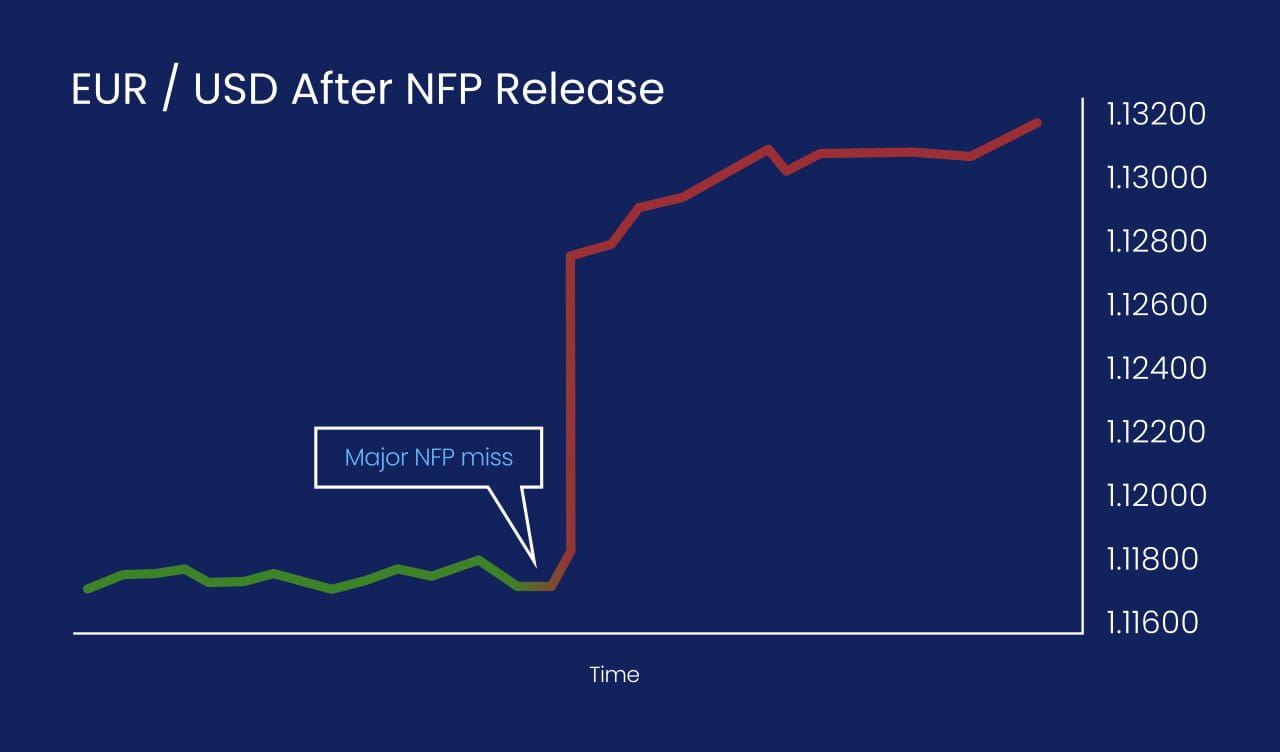Fundamental analysis
Economic indicators and announcements
Economic indicators and announcements are an essential part of fundamental analysis. Even if you’re not planning on finding trades using fundamentals, it’s a good idea to pay attention to how the overall economy is performing.
Here’s a cheat sheet covering six key indicators and announcements to watch out for.
- Non-farm payroll (NFP)
- Consumer price index (CPI)
- Central bank meetings
- Consumer and business sentiment reports
- Purchasing managers index (PMI)
- Retail and vehicle sales
1. Non-farm payroll (NFP)
The non-farm payroll report estimates the net number of jobs gained in the US in the previous month – excluding those in farms, private households, and non-profit organizations. It is usually released on the first Friday of the month, in an ‘Employment Situation’ report that also includes the US unemployment rate, average hourly earnings, and participation rate.
Although its importance has dimmed somewhat in recent years, NFP is still probably one of the most significant economic indicators. Pundits from across the financial markets will attempt to predict the headline NFP figure each month, as well as its potential market impact.
Why is NFP important?
The Federal Reserve has the mandate to maintain ‘maximum employment’ in the US, as well as stable prices. So they’ll pay close attention to NFP when setting interest rate policy. If employment looks strong then they may consider raising interest rates. If it is weak, lower rates could be on the cards.
As the US is the world’s largest economy, any actions by the Fed tend to have a significant impact on global financial markets.
Consensus
As with many economic releases, the markets will usually try to predict where NFP might land before the release itself. Usually, this is done using the average of a group of professional analysts – if NFP significantly ‘beats’ or ‘misses’ this consensus, a major market move may follow.

If it falls roughly in line with expectations, volatility may remain low.
Other employment figures
Of course, NFP only measures employment in the US. It’s also worthwhile checking the employment figures for any economy you’re focusing on in your trading, whether it’s the change in employment in Australia or the unemployment rate in the UK.
2. Consumer price index (CPI)
As we’ve covered, though, central banks don’t just have the mandate of maintaining employment. They also have to ensure ‘price stability’ by keeping inflation steady. The chief measure of inflation is the consumer price index, which measures the changing prices of a group of consumer goods and services.
There are plenty of other inflation measures, however. These include:
- Personal Consumption Expenditures (PCE)
- The producer price index (PPI)
- Import/export prices
- Wholesale price index (WPI)
Each economy has its own CPI figures, released by a different body on a different date. For example, you can take a look at the economic calendar in your FOREX.com demo account to check upcoming reports.
Why is CPI important?
CPI measures the prices paid by most consumers, so central banks tend to pay more attention to it than other indices. Most developed countries prefer CPI to be around 1-3%. If it comes in much higher or lower than that, a change in monetary policy may follow.
3. Central bank meetings
As we’ve seen, most traders follow economic figures so they can anticipate what a central bank might do next. So, it only makes sense that we pay attention to what happens when they actually meet and make decisions.
Each central bank will have its own regular meetings. For example, the Federal Open Market Committee (FOMC) – which is in charge of setting monetary policy for the Federal Reserve – usually meets eight times each year.
Why are central bank meetings important?
Traders will watch for any announcements from each meeting, such as rate hikes or cuts, forward guidance on future policy or any other new monetary measures (such as quantitative easing).
Often, the minutes from a meeting will be released shortly afterwards. This can provide crucial insight into whether key central bank personnel are hawkish or dovish.
4. Consumer and business sentiment reports
Multiple organizations are constantly surveying consumers and business leaders to create sentiment reports. While the number of reports they produce is staggering, they all play their part in shaping the markets’ expectations for the future.
Why are sentiment reports important?
An economy needs businesses and consumers to spend in order to thrive. If businesses and consumers are feeling apprehensive about the economy, then spending tends to be lower – which may impact growth, employment and inflation down the line.
As such, these reports tend to be leading indicators. While employment and inflation figures are reported on past quarters, sentiment reports can give you an insight into what’s going to happen next.
5. Purchasing managers index (PMI)
Purchasing managers indices measure the prevailing direction of economic trends in a given industry, according to the view of its purchasing managers. They are used as an indicator of the overall health of a sector.
Like price indices, there are typically multiple different PMIs released for any given economy.
- A PMI figure of above 50 indicates that managers believe that their business is performing better in the current month than the previous one
- If it is below 50, then managers have seen less activity this month than the last
- If it is at 50, then the current month is on par with the previous one
Why is PMI important?
PMIs are used to get a quick on-the-ground assessment of how a sector is performing from the people working within it. If a key sector in a country is stalling, then the economy may soon follow. On the other hand, if it is thriving, growth could be on the horizon.
6. Retail and vehicle sales
Retail and vehicle sales are two indicators that measure demand for finished goods and demand within the motor industry respectively.
Why are retail and vehicle sales important?
As we’ve seen, economies run on consumer spending. Retail and vehicle sales offer a direct measurement of spending, informing traders of whether consumption is trending up or down.
Retail sales figures give a much broader view of spending and are typically compiled by the government each month. While narrower, vehicle sales can be a little bit more expedient as they are released by businesses themselves. Many traders believe that vehicle sales can offer an insight into general spending, so will use them as a leading indicator for the retail figure.

